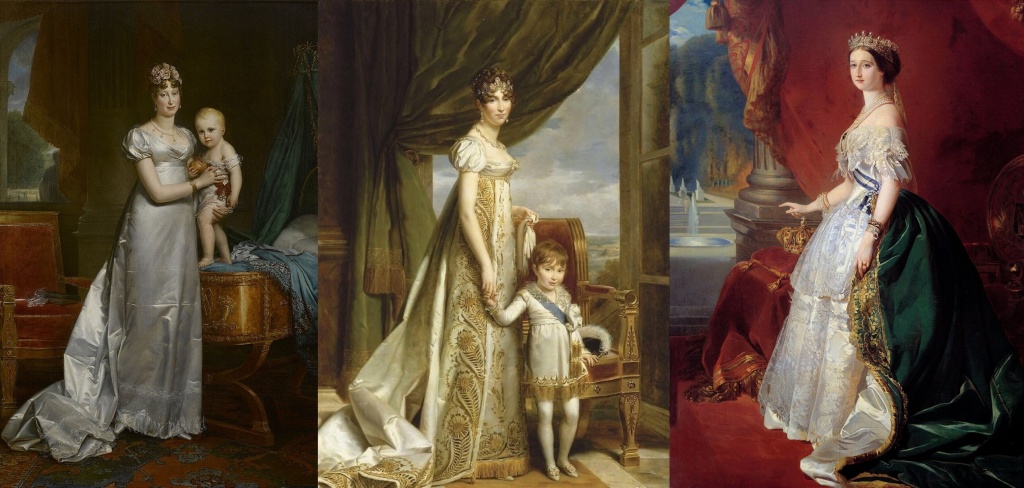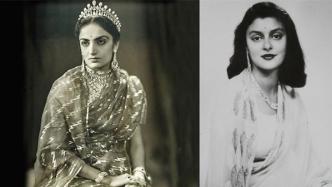
The Indian subcontinent has a long history of jewelry and has had a profound impact on world jewelry and arts and crafts. Indian jewelry is not only a rare cultural relic in a well-known auction house, but also a top collection of big collectors such as the British royal family and the Qatari royal family (The AL Thani Collection). Indian jewelry is the treasure of art collection institutions such as the Metropolitan Museum of Art in New York (The Met), the Victoria and Albert Museum (V&A), and the Dallas Museum of Art (Dallas Museum of Art), and is rarely open to the public.
Indian jewelry is not only the treasure of the royal family, but also lays the artistic foundation for the advanced custom jewelry of modern workshops. This article combines the recent exhibitions of jewelry cultural relics to sort out the art of Indian princes and high-end custom jewelry.
The most expensive jewelry in the world
In 1907, the Maharaja of Nawanagar in India customized the Belle Époque Diamond Jigha at Cartier. The feather crown is made of platinum and diamonds, and is cut into a rectangular or pear shape, inlaid with feathers. The diamond at the bottom of the feather crown can be flexibly removed and can be used as a headdress and a brooch.
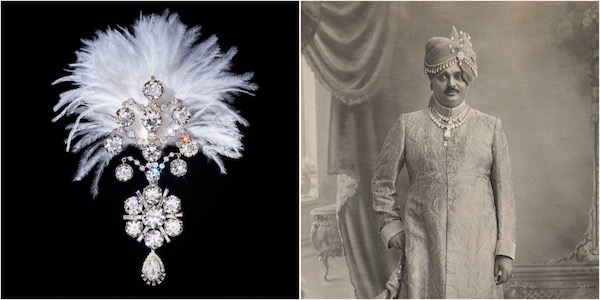
The Maharaja of Navanagar wearing a Belle Époque diamond crown
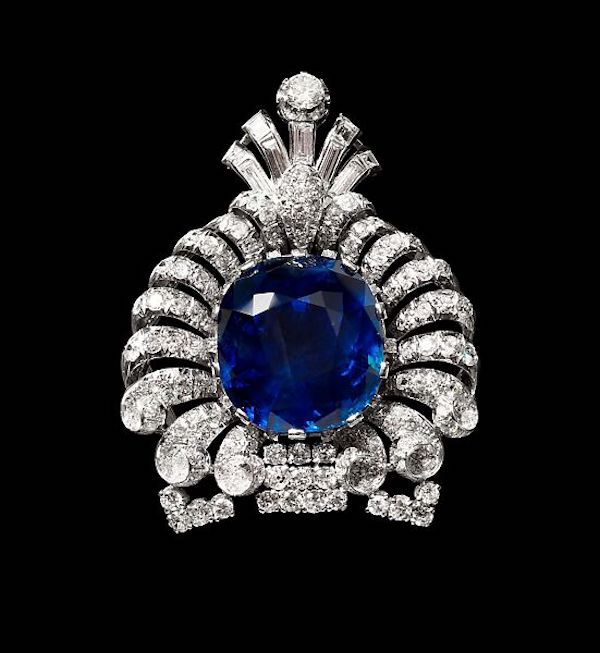
Sapphire tiara or brooch, 1920, origin: Nawanagar, India, material: white gold, sapphires, diamonds, collected by the royal family of Qatar
Another treasure of the Maharaja of Navnagar is a cushion-shaped sapphire customized in the 1920s. Sapphire is produced in Sri Lanka and inlaid with white diamonds and platinum. It can be used as a headdress on a turban or as a brooch on the chest.
In 1925, Maharaja of Patiala Yadavindra Singh purchased the Patiala Necklace for 1 billion Indian rupees, equivalent to US$2.7 billion today.

Patiala necklace worn by Findra Singh
The Bertiala Necklace includes 5 layers of diamond chains and a choker, including 2930 diamonds and Burmese rubies. The large diamond in the center is the seventh largest diamond in the world at the time, De Beers of South Africa, weighing 428 carats. , is the largest cushion-shaped yellow diamond and the second largest yellow diamond in the world. Other large diamonds range from 18 to 73 carats.

Patiala ruby necklace, 1931, restored by Cartier in 2012, material: rubies, diamonds, pearls, platinum, collected by the Qatari royal family
As famous as the Patiala necklace is the Patiala Ruby Choker. The customer was also the Maharaja of Patiala, India. In 1931, he gave this necklace to his wife.
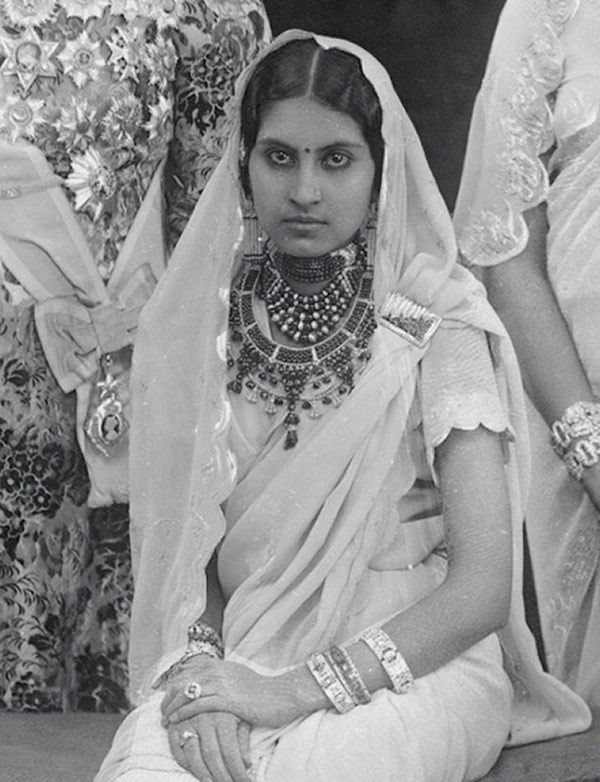
The princely queen wearing the Patiala ruby necklace, 1931, photo: National Portrait Gallery
The Patiala ruby necklace later disappeared, and its whereabouts remained a mystery until nearly 70 years later, in 2000, when it appeared as a bracelet in a Swiss auction house and was later collected by the Qatari royal family.
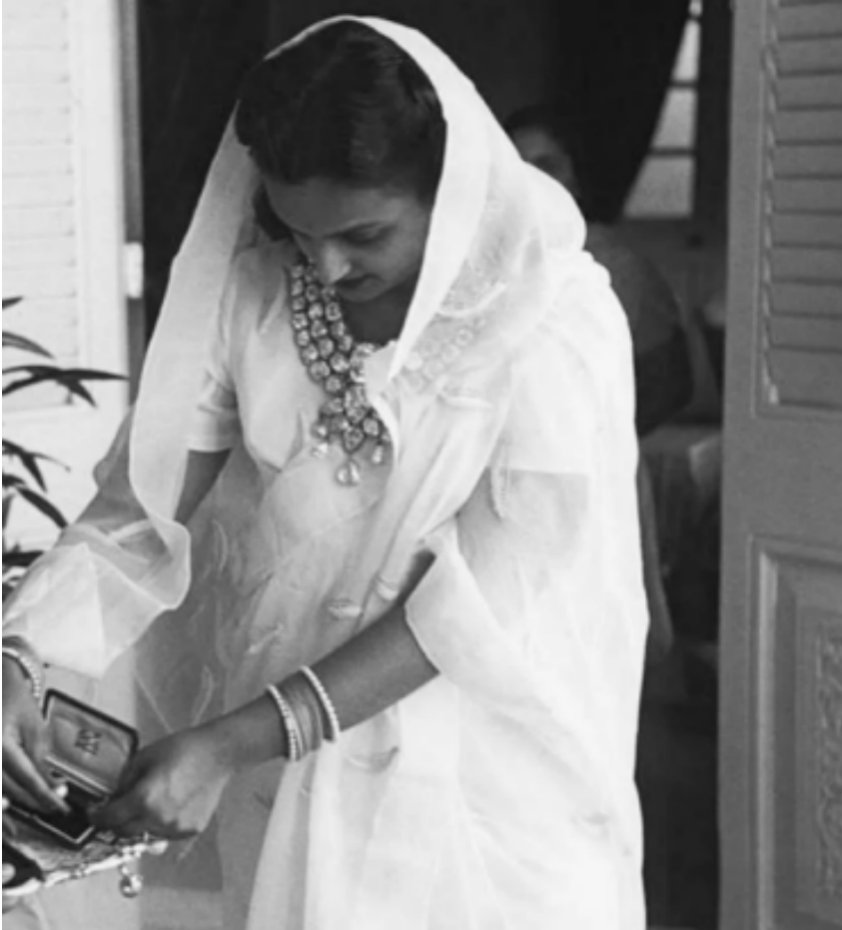
Maharani Sita Devi of Baroda, Queen of Baroda, India, wearing the Star of the South three-layer diamond necklace
The Taj Mahal Emerald also experienced a similar mysterious disappearance and recovery. This piece of jewelry customized by Cartier in 1925 was originally called the Collier Bérénice shoulder piece. After being exhibited at the Internationale des Arts Décoratifs et Industriels Modernes in Paris, its whereabouts were unknown and it changed hands many times among private collectors in Europe.
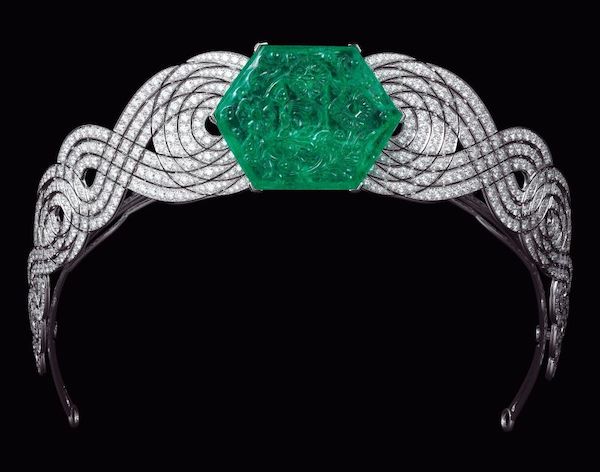
Taj Mahal Emerald Crown, 1925, Origin: India, restored by Cartier, collected by the Royal Family of Qatar
It was not until the 1980s that the Collier Bérénice epaulet reappeared on 47th Avenue in New York. In 1990, it was exhibited at the "Romantic Taj Mahal" exhibition at the Los Angeles County Museum of Art. At this time, the jewelry was incomplete and only one piece remained. The whereabouts of the green jasper and most of the others are still unknown.
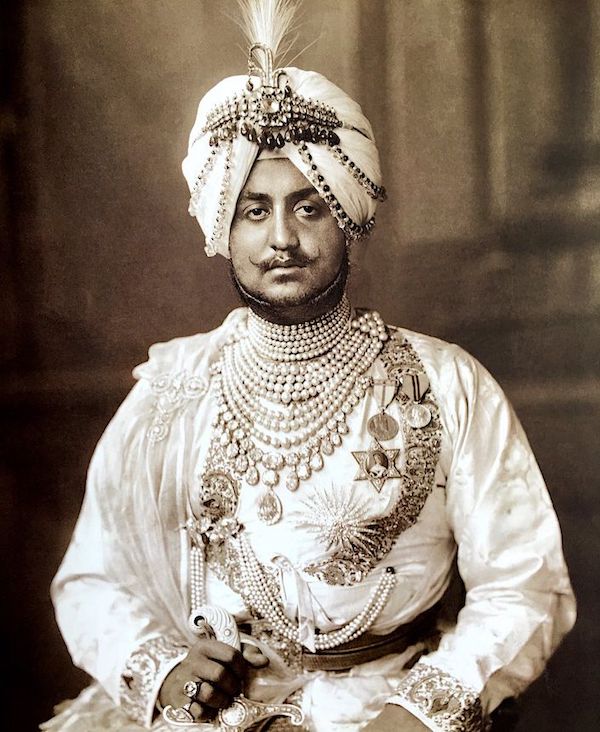
Maharaja Bapinder Singh wearing jewelry
Indian princes were important customers of French jewelry workshops and left a large number of collectible cultural relics to jewelers. In 1928, the Maharaja of Patiala, Bhupinder Singh, arrived in Paris, France with 40 entourage. He stayed at the Ritz Hotel and searched for a suitable manufacturer of custom-made jewelry at a jewelry store in Place Vendôme in Paris. Finally, he locked on the treasure. Bourcheron, Louis, the son of Frédéric Boucheron, the head of Boucheron, personally received him and made emerald and diamond necklaces, pearl necklaces, and colored diamonds for the prince. The 149 pieces of jewelry, including belts, replicate the essence of Indian craftsmanship.
Gem of the Womor Empire
The jewelry of the South Asian subcontinent has a history of more than 5,000 years and originated from the Indus River Basin, which is now Pakistan and northwest India. In 1500 BC, humans began to manufacture jewelry in the Indus Valley. India was also the first country in the world to mine diamonds, dating back to 296 BC.
The Womer Empire was an Islamic empire established in the South Asian subcontinent by Babur, a descendant of Genghis Khan and Timur. It was the last dynasty before the colonial era in India. From the mid-16th century to the official demise of the Indian National Revolt in 1857, the dynasty existed for more than 300 years. As a Turkic Mongol dynasty originating from what is now Afghanistan, the Omor Empire created an aesthetic with a strong Persian and Islamic style.

Shah Jahan, Emperor of the Wolmor Empire wearing jewelry
The kings of Womor used jewelry to express their sustenance for eternity and immortality. They usually set their names on jewelry and passed it down to the next generation. Jewelry was also used to purchase military supplies, raise funds for wars, and even launch revolutionary uprisings and overthrow regimes. It was also used to exchange prisoners of war and honor victorious warriors.

The stone inscription "Jahangir, son of Akbar" on the ruby of Sarpeh's crown, circa 1633, collected by the royal family of Qatar
The Sultan of the Womor Empire loved jewelry and regarded jewelry as a symbol of the imperial power. Womer jewelry originated from the third generation of Sultan Akbar the Great, who was keen on collecting jewelry throughout his life. His son Jahangir inherited his jewelry tradition. In the generation of grandson Shah Jahan, Womore jewelry reached the pinnacle of aesthetics. By the time of the sixth sultan Aurangzeb, the Womer Empire had controlled the Golconda mining area in India and controlled what became the only known diamond mine in the world at that time.
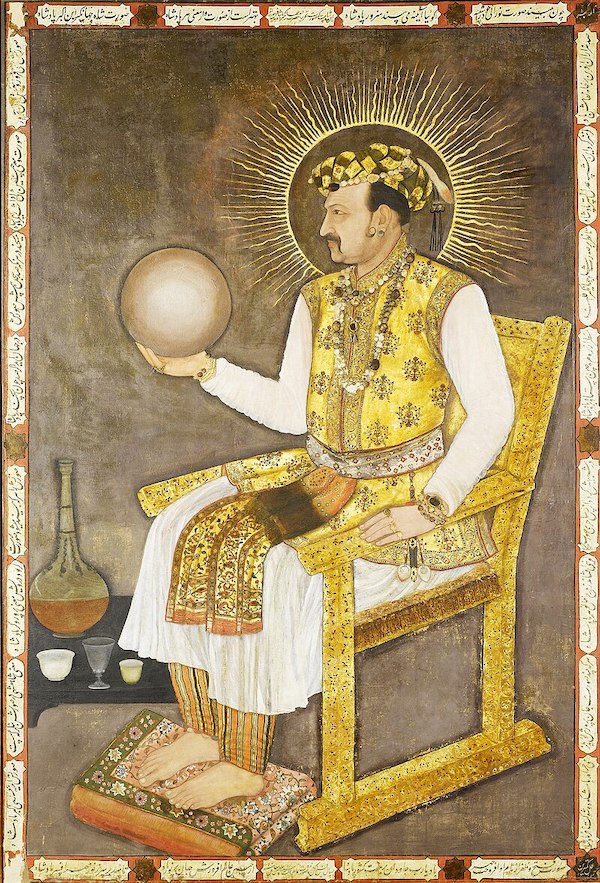
Sultan Jahangir on the throne, all jeweled, 1617. Photo: Bonhams
Shah Jahan, the fifth sultan of the Womer Empire, was not only the builder of the Taj Mahal, but also the master of Womor jewelry. According to Indian miniature paintings, Shah Jahan often wore jewelry and expressed his imperial power through necklaces, headdresses, brooches and other jewelry.
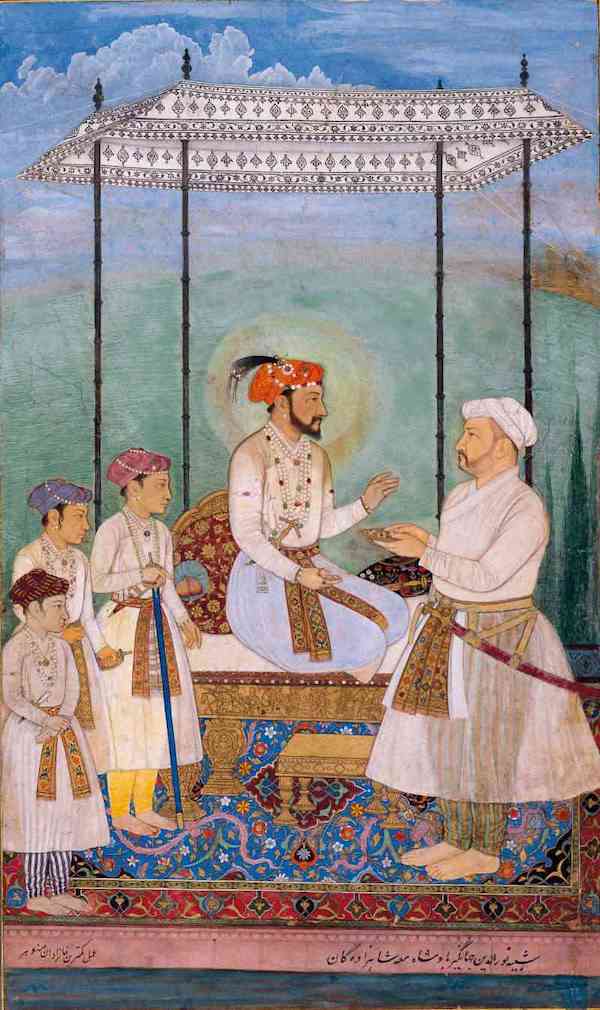
Shah Jahan, three sons and their biological father Asaf Khan IV
The Wolmor Dynasty regarded diamonds as treasures and usually did not cut them. The largest diamond reached 250 carats. Emeralds were imported from South American mining areas, especially Colombia. Balas rubies were especially loved by Jahangir. , originating from his hometown of Badakshan in present-day Afghanistan.
As rulers who believe in Islam or Sikhism, the Sultan of Womol and the princes and nobles of the princely states are accustomed to wearing turbans, and regard the headdress on the turban as a symbol of power. The headdress is the iconic Womore jewelry. The more expensive and heavy the headdress is, the higher the status and power of the owner.
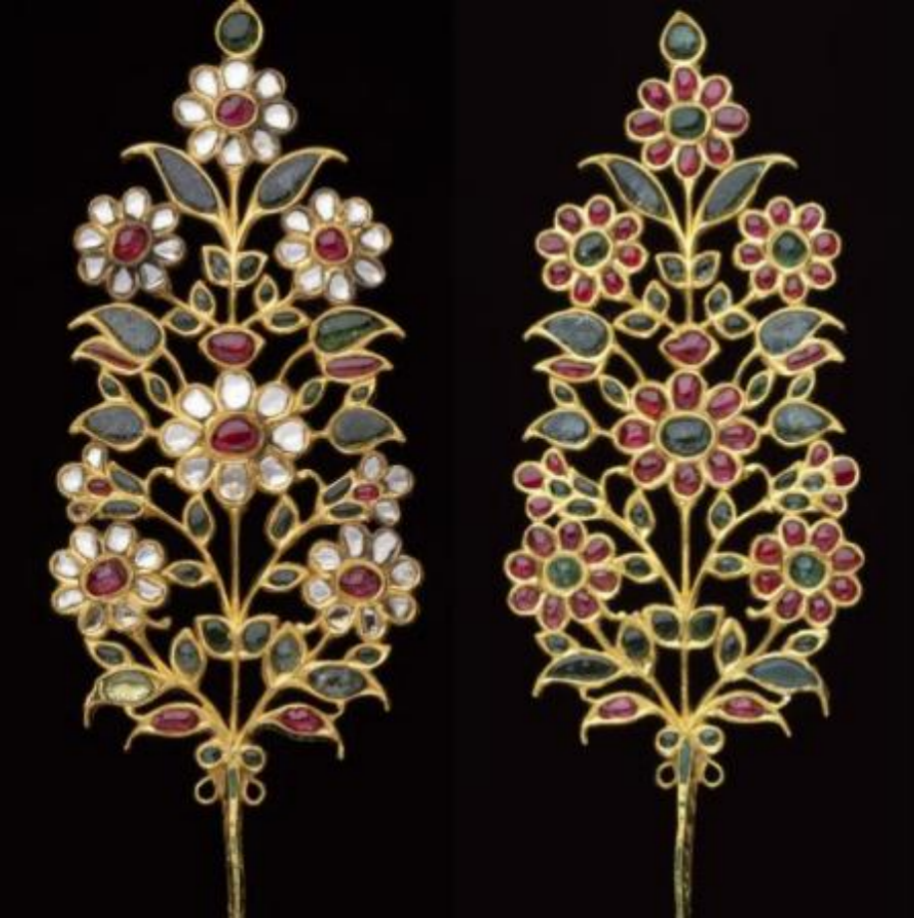
Crown of a heron of the Maharaja of Jaipur, early 18th century, V&A Museum
Aigrette is a common headdress of Wolmor. In the mid-18th century, Emperor Womol gave a bouquet-shaped heron crown to the Maharaja of Jaipur, Rajasthan. The heron crown was made of rubies, emeralds, diamonds, pale beryls, and was inlaid with translucent enamel. Among them, blooming flower bouquets, which symbolize nobility, wealth and exquisite traditional craftsmanship, are a common theme in Womol art and often appear in 18th-century Rajasthani paintings. From 1922 to 1923, this treasure was collected in the Victoria and Albert Gallery (V&A) in the United Kingdom.
The diamond crown of Pratap Singh Rao Gaekwad, the Maharaja of Baroda in India, is also very famous. The manufacturer is Cartier. The crown of the heron is made of diamonds and white gold and is cut in cushion, pear, oval and pear shapes.
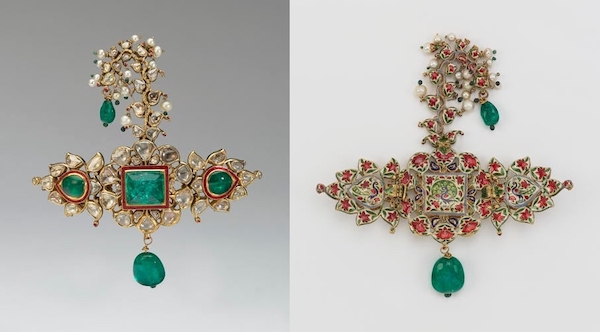
Tiara of the Maharaja of Udaipur, India (front and back), 19th century, material: emerald, diamond, gold, pearl, enamel. Collection of the Royal Collection Trust (RCT)
Sarpech means "something twisted in front of the turban" in Persian. It is a common headdress for men in Womor and is in the shape of a cross. The Salpeh tiara from Udaipur, Rajasthan, India, collected by the British royal family, is inlaid with emeralds and gold rims on the front and pendant with pearls. The back is embellished with red, green, blue and white enamel, showing flowers or Peacock shape. In 1875, King Edward VII of England visited India. At a banquet in Bombay, the prince gave this tiara as a gift to Edward, the Crown Prince of Wales at the time.
The gorgeous crown is also a symbol of the power of Indian princes. The prince wears a large crown outside the Sikh turban, and his chest and waist are also covered with layers of jewelry and belts, symbolizing his noble royal power.

Left: The Maharaja of Patiala (Yadavindra Singh) wearing the crown Right: The Maharaja of Kapurthala Jagatjit Singh wearing the crown
The Womor Empire also had a tradition of making brooches or headdresses with portraits of kings. In the miniature painting "Shah Jahan on a Terrace, Holding a Pendant Set with His Portrait" (Shah Jahan on a Terrace, Holding a Pendant Set with His Portrait), Sultan Shah Jahan embedded his portrait into the pendant, holding the pendant as a symbol of Power, and wearing a string of pearls around his neck.
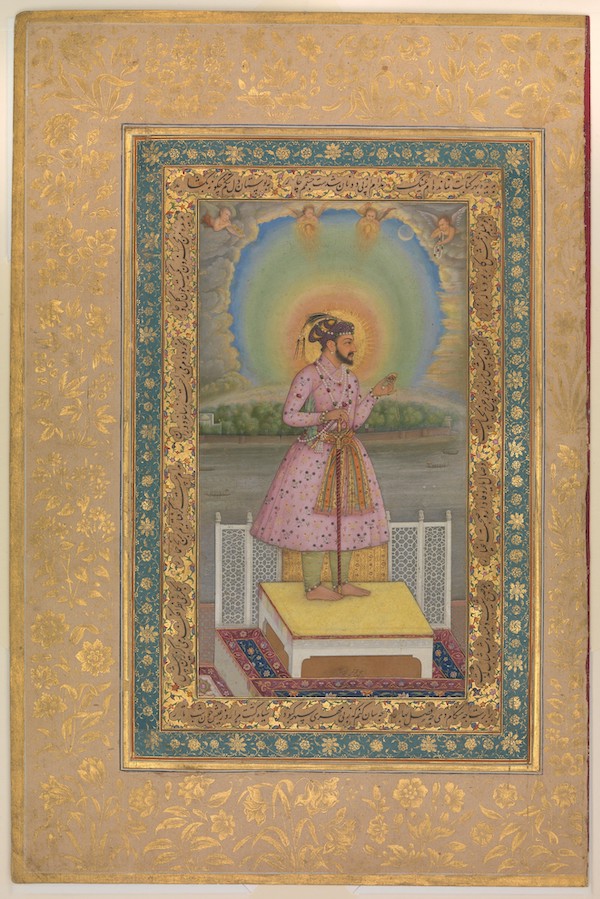
"Shah Jahan Standing on the Throne Holding a Pendant", Indian Miniature Painting, 1530-50, collected by the Metropolitan Museum of Art, USA
In the Indian state of Jodhpur (Jodhpur) at the end of the 19th century, wearing a headdress with the portrait of the previous prince became a ritual for passing on power. Sardar Singh, the prince of Jodhpur, wore a headdress made with the portrait of the Sultan, symbolizing power. Passed down from generation to generation.
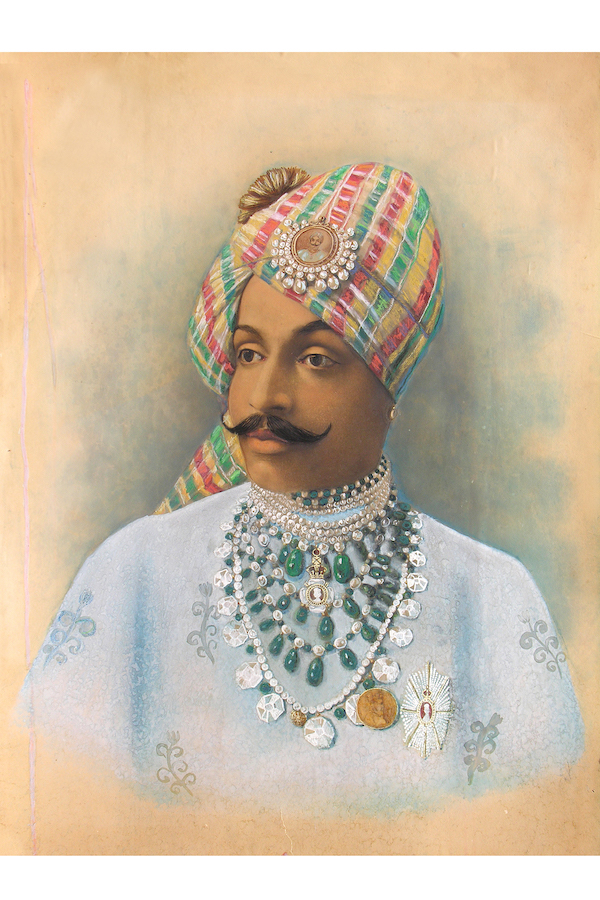
Sardar Singh's headdress, made from the portrait of the Sultan
The sultans of the Wolmor Empire, especially the rulers who believed in Sikhism, were famous for their bravery and prowess in battle. It was also a noble tradition to wear long swords inlaid with jewels.
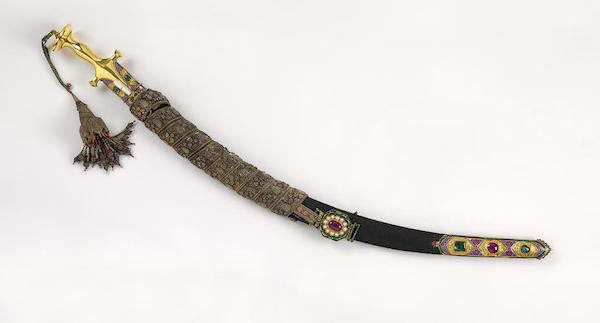
Womore sword, materials: ruby, emerald, pearl, leather, gold, steel, 19th century, collected by the Royal Collection Trust
The Wolmor sword is curved in a streamlined shape, inlaid with rubies and emeralds, and the scabbard is engraved with the name of the Khan of the Talpar dynasty in Persian. The Sindh region where the Tapur Dynasty was located is located in present-day Pakistan. The Khairpur palace was deeply influenced by Iranian style, and most of the craftsmen of the dynasty came from Iran.
After the Indian soldiers revolted in 1857, the Sultan of the Womor Empire was exiled by the British. The Womor Empire collapsed. Womor jewelry began to scatter all over the country, and most of the treasures fell into the hands of European and Asian royal families.
Hyderabad and South Indian Jewelry
After the demise of the Womor dynasty, some old princes, monarchs and families continued to inherit the princely territories, signed treaties with the British colonial authorities, and continued to exist as a dependent state of British India, that is, a princely state. These princely states are located in northwest, central and southern India. They inherited the essence of Wolmor and Indian jewelry craftsmanship and developed South Indian style jewelry.
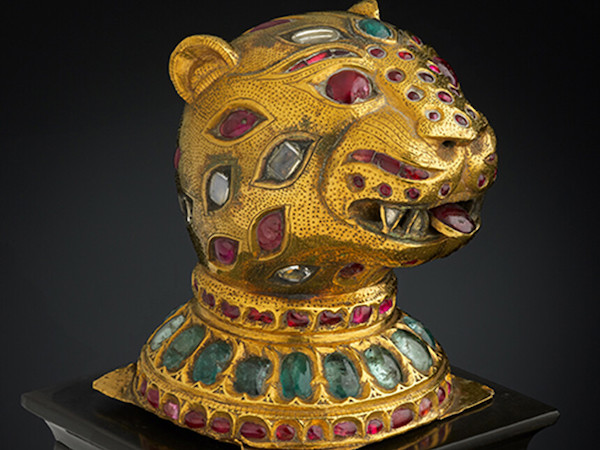
Finial from the Throne of Tipu Sultan (Finial from the Throne of Tipu Sultan), 1790, Origin: Mysore, India, Material: Gold, diamonds, rubies, emeralds, lac core, Collection of the Royal Family of Qatar
After the British invaded India, the Indian princes rebelled, and Tipu Sultan of the Kingdom of Mysore became famous. He participated in four Anglo-Mysore wars and was killed in action in 1799. Mysore was conquered by the British and became a princely state under its jurisdiction, and was controlled by the British Governor.
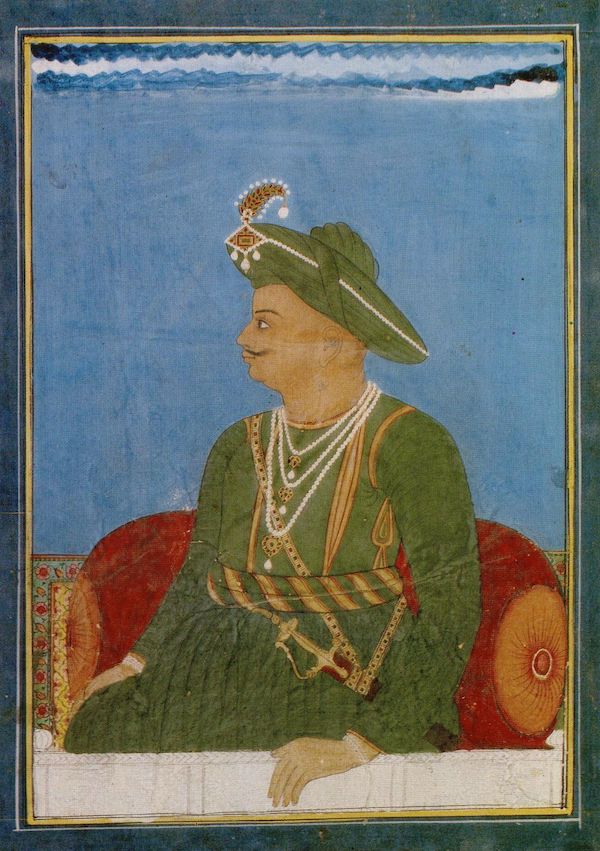
Tipu Sultan
Tipu Sultan’s determination to defend his land and his tragic ending make his jewelry legacy particularly touching. His throne is octagonal, with eight pointed corners inlaid with tiger heads. In 1799, the British killed Tipu Sultan and the throne was destroyed. Today, only a tiger head is left. In 1833, this cultural relic entered Canada and was collected by a private collector. In 2009, it was purchased by the Qatari royal family and kept in Paris, France.
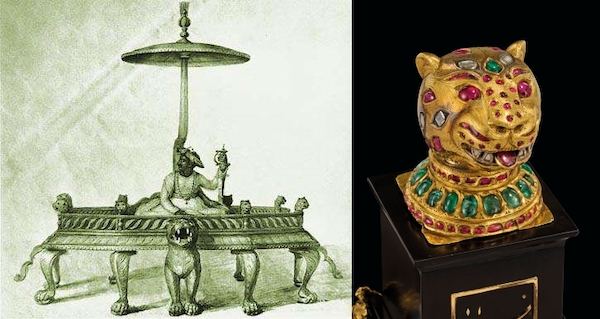
Tipu Sultan's throne and tiger head spire
The sword of the prince of Mysore has a golden divine lion (Yali) inlaid on the hilt, symbolizing the prince's unparalleled courage and kingly style. Yali is an Arabic word that refers to the leogryph, which is half tiger, half elephant, and half horse. It often appears in Indian mythology.

Divine lion-hilted sword, 1800, origin: Mysore or Tanjore, India, material: gold, diamonds, rubies, emeralds, steel, collected by the royal family of Qatar
Other princely states in central and southern India relied on survival strategies and tenacity to coexist with British India, and even joined the Indian Union after the establishment of independent India. The Nizam of Hyderabad was an independent feudal kingdom that lasted for more than 200 years until it was annexed by India in 1948.
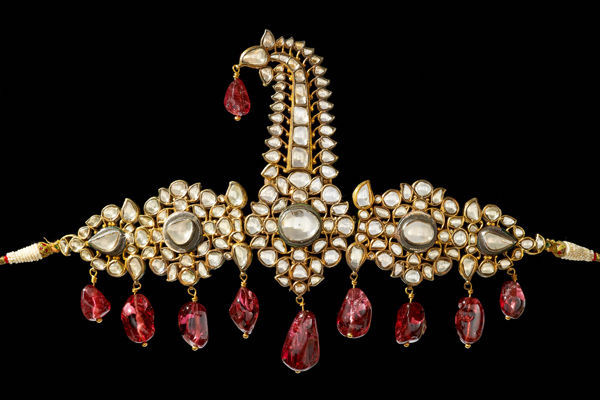
Salpeh Crown, Hyderabad, 1800–50, Collection: The Royal Family of Qatar
Hyderabad was once a fiefdom of the Womor Empire in the Deccan Plateau and maintained a semi-independent nature for a long time. This allowed the royal family to preserve its feudal power and wealth. The last prince of Hyderabad (Mir Osman Ali Khan) was once the richest man in the world.
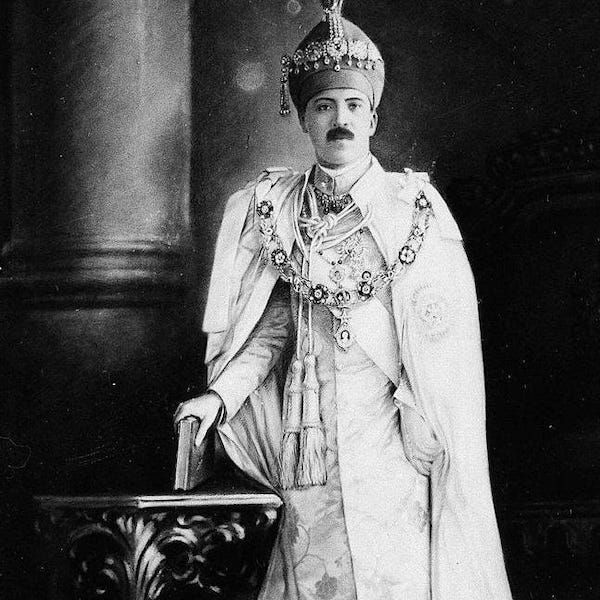
the last prince of hyderabad
The jewels of the Maharaja of Hyderabad are the best-preserved princely jewelery collection system in India. The Maharaja of Hyderabad is also a luxury buyer in the jewelery industry, and is famous for the huge gems in his tiara. The emerald tiara is composed of Colombian emeralds, supplemented by Indian and European-style designs; the Penguin blood ruby tiara weighs 100 carats, is equipped with 3 golden drop-shaped diamonds, and can be split into 6 separate jewelry.
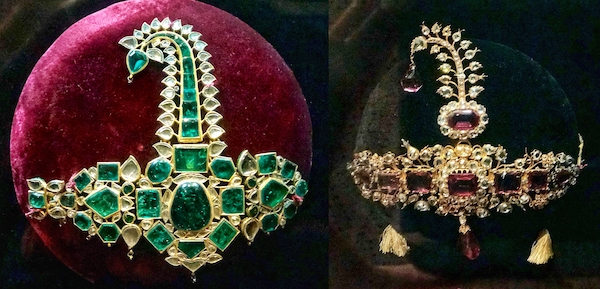
Hyderabad Salpeh tiara Picture: Wiki
Earrings are also popular in the jewelry of South Indian princely states. Odisha's Karanphul Jhumka earrings are made of bell-shaped earrings and red emeralds, with a mandala-like flower composition.
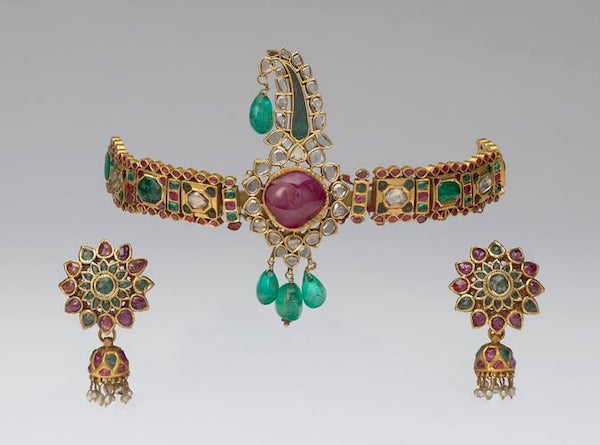
Headdress and earrings, Origin: Orissa, India, 1875, Collection of the British Royal Family
Stones of Faith, Jewelry as Cosmic Astrology
In Hindu belief, jewelry represents the stars in the celestial universe and can be used for divination, like a prophet. In Indian philosophy, the prince is the center of the world. The prince is the incarnation of God, a god in human form. His duty is to protect Dharma and maintain the moral order of the universe.

The headdress of the prince of Jaipur, the peacock symbolizes the Hindu god Krishna
As early as the 5th century, a work on the study of gemstones, "Ratnapariksa" (Ratnapariksa), appeared in India, describing the relationship between gemstones and gods, planets and calendars.
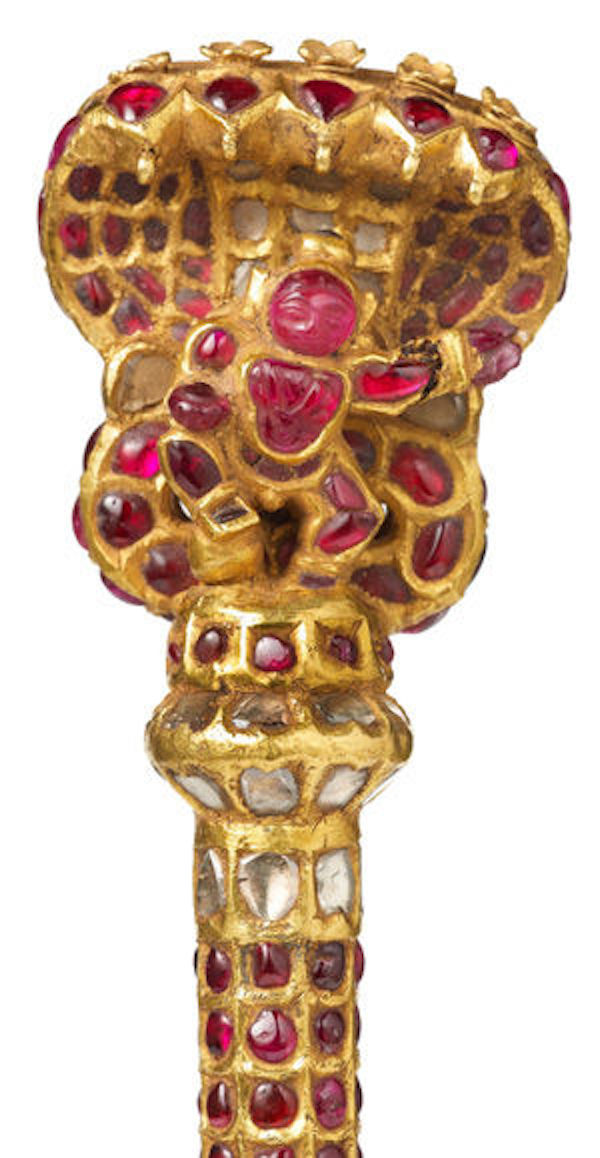
Uddharane, 1822, origin: South India, ruby symbolizes the sun, used to carve the dancing god Krishna, collected by the royal family of Qatar
Some gemstones are considered to be evil stars with bad luck, such as ruby, sapphire, coral, red zircon, cat's eye, etc. Sapphire symbolizes Saturn and Saturday, and is the incarnation of the god Shani, the predictor of misfortune and retribution; while pearls, Diamonds, emeralds and topaz are the embodiment of good luck.
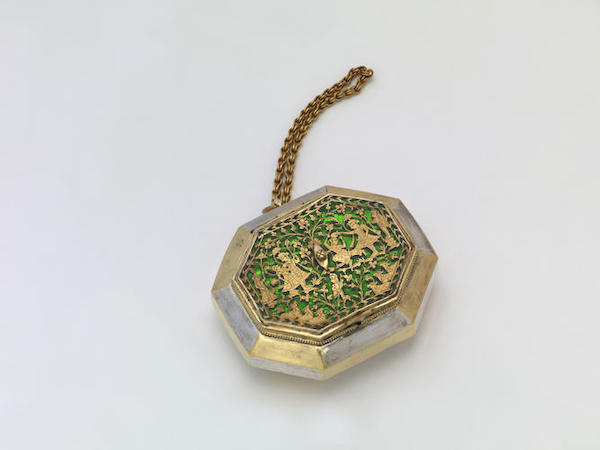
Opium box with Lord Krishna and a herd, 1875, Origin: Rajasthan, India, Material: coated silver, glass, gold, Royal Collection Trust
Hindus believe that gold represents the warm sun and silver represents the cold moon, and gold is the embodiment of eternity and immortality. Gold has symbolic significance in Indian literature. According to the Indian classic "Vedas" about the universe, human spiritual and material life originates from the golden womb (hiranyagarbha) or golden womb, which floats in the cosmic ocean and gives birth to the entire universe. , is the core of the early creation concept, the golden fetus is equal to the sun.
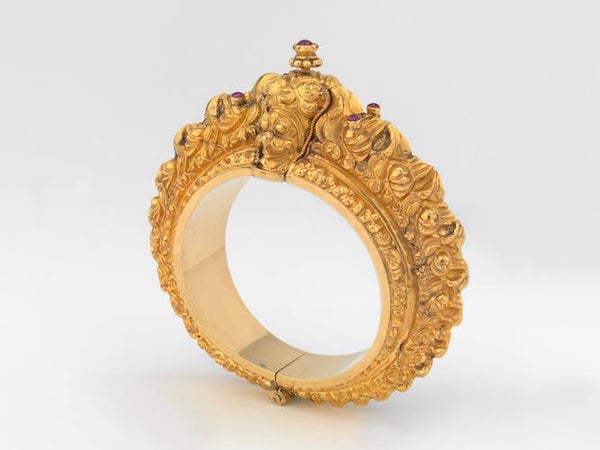
Anklet inlaid with Lord Maharaja, 1850-1875, Origin: India, Material: gold, ruby, Royal Collection Trust
Navaratna is the most astrologically significant Indian jewel. The nine gemstones include diamond, pearl, ruby, sapphire, emerald, cat's eye, topaz, coral and red zircon. They represent the nine gods in the Hindu universe, with ruby as the center, symbolizing the sun, the center of the universe. Wear it The nine gems are to wear the nine stars of the entire universe on the body to maintain harmony and balance.
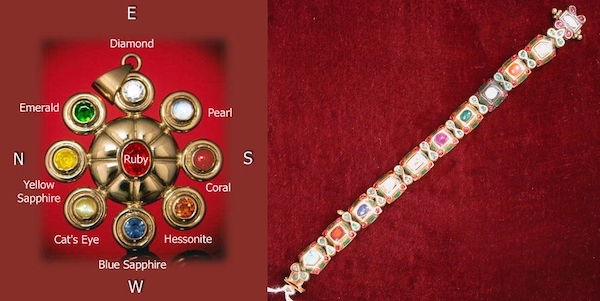
nine gems
The nine gods represented by the nine gems can only maintain a harmonious relationship through rituals, giving and prayers, otherwise the gods will bring endless disasters and hysteria. Once it is necessary to come to the world or come to protect mankind, the gem is the place where the gods come.
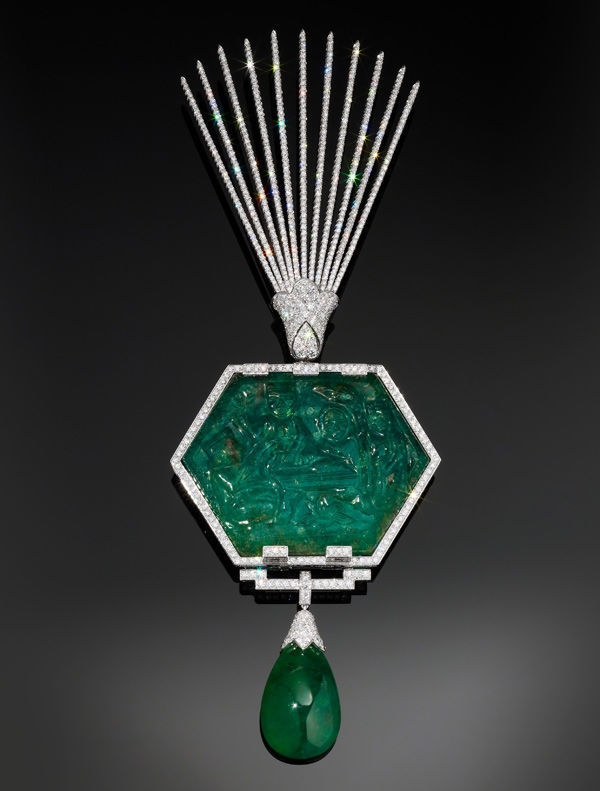
Ramayana-themed emerald heron crown, material: emerald, diamond, platinum, made by Cartier, collected by the royal family of Qatar
The emerald symbolizes Mercury and Wednesday, the incarnation of the gentle and eloquent Buddha, the favorite of Emperor Wolmor. The emerald jewelry customized by Cartier for an Indian prince weighs 380.89 carats. The engraved pattern comes from the Indian epic "Ramayana" and serves as an amulet for the Sultan. Rama, Sita and the monkey Hanuman are engraved on the emerald. The monkey is widely worshiped in India and is the embodiment of strength, courage, loyalty and morality. The monkey is engraved on the amulet to bless the wearer with wealth, peace and health. .
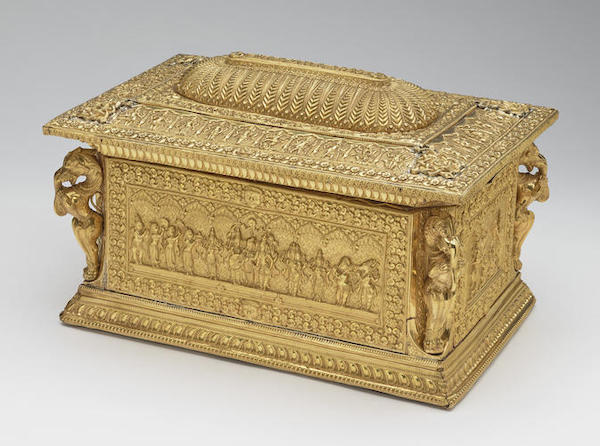
Jewelry box with Lord Sābāmī and the divine lion. Origin: Madurai, South India. 1875. Gold. Collection of the Royal Collection Trust.
Hindu gods and mythological stories are the themes of antique Indian jewelry. The Hindu totem "gaja-lakshmi" composed of Swami, Lakshmi, Lakshmi and elephants, Subramanya, the god of war, and Magha Makara, Yalis, etc. are common themes in Indian jewelry.

Tiger claw pendant brooch, engraved with the Jahar-Lakshmi totem and Kumarajiva, 1870, material: gold, tiger claw, Royal Collection Trust
Today, among Hindu and Jain believers, jewelry is still an important wedding equipment and a dowry for the bride, which can protect the wealth after marriage. In Indian weddings, the bride wears jewelry on her arms, wrists, ears, nose, hair, toes and waist, which has the function of blessing from the gods and astrological implications.

Jaipur incense box, India, 1870-1875, enamel, Royal Collection Trust
Indian Inspiration in Contemporary Haute Couture Jewelry
After the British colonists came to India, they greatly discovered the value of Indian jewelry and promoted it to Europe. During the British Raj, Indian jewelry had East India Company style and European elements.

Brooch with the theme of the Prince and Princess of Wales, Origin: Madhya Pradesh, India, 1875, Material: gold, glass, Collection of the Royal Collection Trust
After the Indian National Revolt in 1857, the British East India Company was dissolved, and British property and land in India were officially included in the British Empire. In 1876, Queen Victoria of the United Kingdom received the title of Empress of India. On New Year's Day of 1877, Queen Victoria held a coronation ceremony in Delhi, India, becoming the only British monarch to hold the title of Empress.
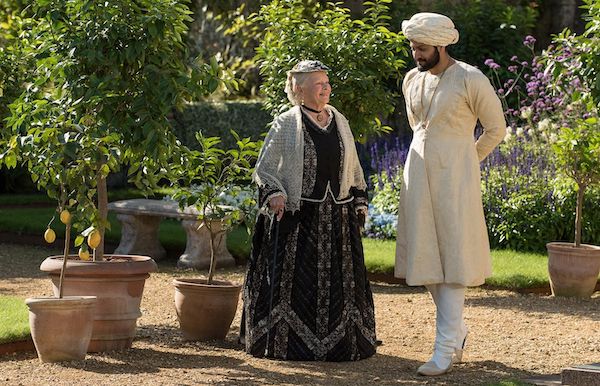
Queen Victoria and Indian Servant, Picture: Still from the movie "Victoria and Abdullah"
In 1911, King George V was crowned in Westminster Abbey, England. In the same year, a grand Durbar coronation ceremony was held in Delhi, India. He wore an Indian crown specially made for him and was the only person to personally chair Durbar. Ceremony of the Indian Emperor.
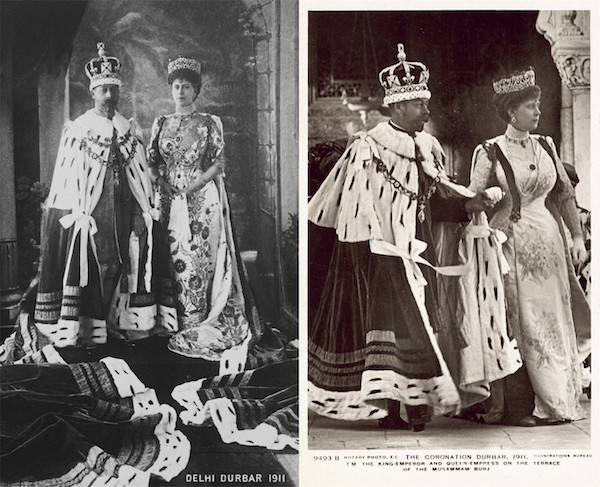
Durbar Ceremony of King George V in Delhi, British India
The British royal family combined Indian jewelry with the British royal crown. Through the merger of the crown, it demonstrated the British Empire's rule over India. The crown of the British monarch is inlaid with jewelry and precious gems from India. The most dazzling gems on the crown are treasures plundered from India during the British Raj in the 19th century.
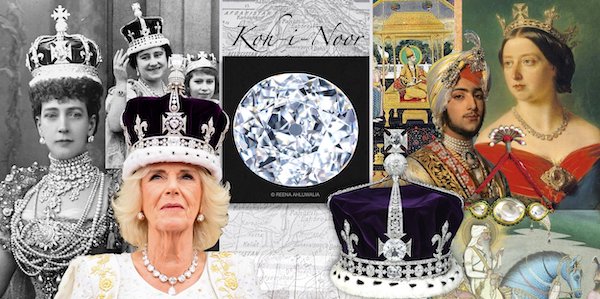
The Koh-i-noor diamond in the British royal crown originally belonged to the Womor Empire of India
To this end, the Indian government had a protracted dispute with the British Crown, dating back to the fourteenth century. The Queen of England once wore the Koh-i-noor diamond worth 100 million pounds (approximately RMB 956 million). This diamond weighed 105.6 carats and originated from Golconda, India. The rough stone weighed 800 carats. , it was owned by Sultan Babur of Wolmor in 1526, became a trophy of the Persian King Nadir Shah in 1738, and was held by the British royal family in 1850.
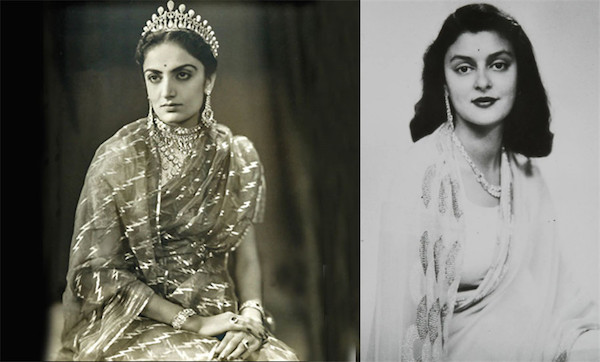
The Nizam of Hyderabad Necklace of the British Royal Family comes from the Royal Family of Hyderabad State, India
There is a passage in Hindu scriptures describing the Mountain of Light diamond: "Whoever owns it owns the whole world. Whoever owns it has to bear the disaster it brings. Only God or a woman owns it. Will bear any punishment."
Jewelry of the last queens of Indian princely states
Indian jewelry is not only the treasure of the royal family, but also lays the artistic foundation for the advanced custom jewelry of modern workshops. The Art Nouveau jewelry of the early 20th century was inspired by Indian jewelry. At the beginning of the 20th century, Cartier used the Taj Mahal as the theme and emerald as the material to produce the Collier Bérénice series of forehead crowns and necklaces.

Collier Bérénice Collection by Cartier
In 1905, Spanish dancer Anita Delgado married the Maharaja of Kapurthala in Punjab, India, becoming the first Hispanic Indian prince's wife. She wore a peacock tiara to attend the royal wedding of Spain's Alfonso VIII. She became famous and was awarded the title "Prince Love".
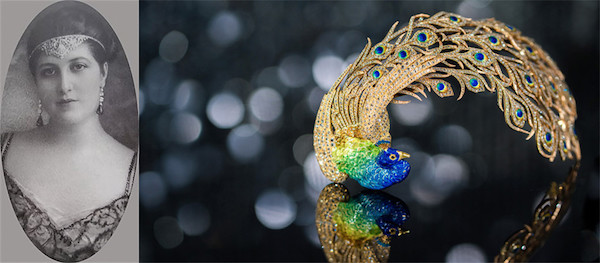
Hispanic Indian princely queen Anita Delgado and peacock crown
In 1910, French decorative arts illustrator Paul Iribe designed an emerald heron crown inspired by the jewelry of Indian princes. It was made of emeralds, sapphires, diamonds, pearls and platinum and was produced by Paris jewelry workshop Robert Linzeler.
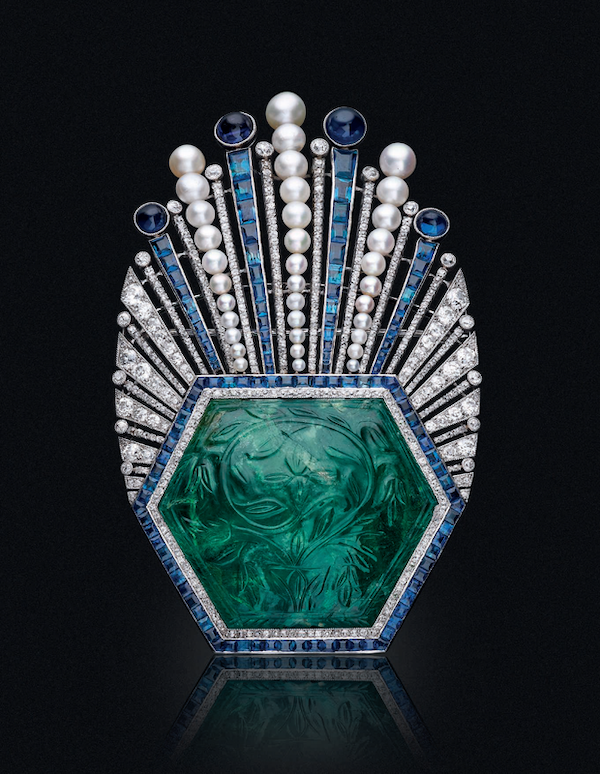
Jewelry designed by Paul Iribe, 1910, from the collection of the Royal Family of Qatar
In 1911, members of the Cartier family first set foot in India and began to look for design inspiration for custom jewelry in India. Inspired by the colors of Indian fruits, Cartier carved rubies, sapphires and emeralds into leaves, flowers and berries in a gorgeous Art Deco style.

French socialite Daisy Fellowes wears Cartier “Fruit Tips” style jewelry (photographed in 1936)
In the 1970s, this group of ideas with the theme of Indian fruits began to be called “Tutti Frutti” (Tutti Frutti), and became a theme that Cartier constantly revisited with variations.
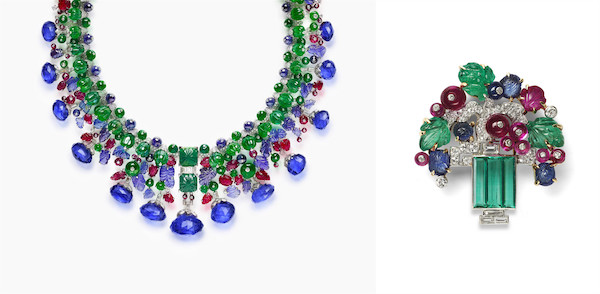
Fruit Tips Series Photo: Cartier
In recent years, Indian jewelry has continued to provide new inspiration to the fashion world. In 2016, Cartier launched Rajasthan (Rajasthan) high-end jewelry. Among them, the "Fruit Kit" necklace is the largest in history, inlaid with 136.97 carats of Colombian emeralds and exquisite floral patterns.

Boucheron’s new Indian Maharaja collection Photo: Boucheron
Boucheron, who once made jewelry for the Maharaja of Patiala, Bapinder Singh, launched the Bleu de Jodhpur jewelry series in 2015, using sapphires with diamonds and crystals to present blue walls and White roof.
In 2022, Boucheron will launch the new Maharaja series of Indian princes, which will renovate and innovate the jewelry customized for the prince in 1928. Turning emeralds into brocade pendants, intertwining them into rich and gorgeous tassels to form men's tie-shaped necklaces, it began with the original intention of traveling to exotic countries and continuing and sublimating traditional culture. It has not changed after a hundred years.
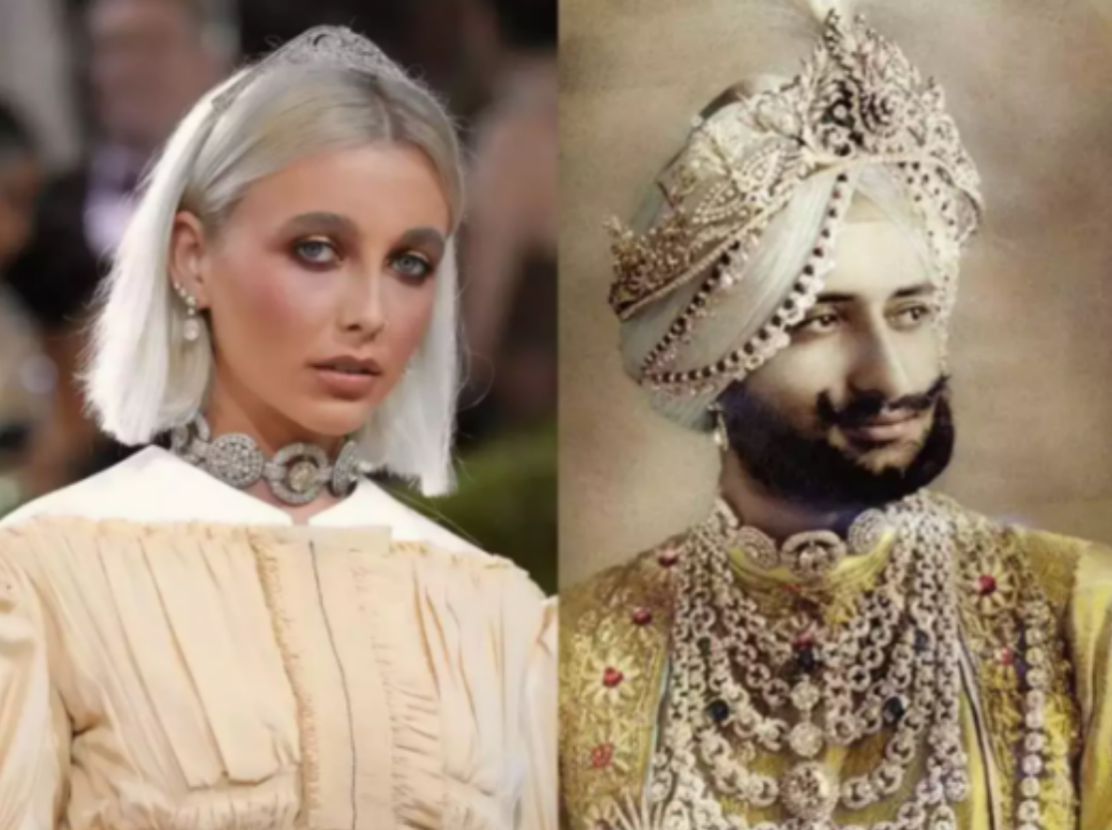
Met Gala Ball Reveals Indian Maharaja Jewelry
In 2022, at the Metropolitan Museum of Art Charity Ball (Met Gala) with the theme of "Gilded Glamor", actress Emma Chamberlain received Cartier's loan permission and wore the original version of Indian Maharaja Yadavendra Singh. The choker, although highly controversial and considered disrespectful to cultural relics, provides a glimpse into the powerful influence of Indian jewelry on contemporary fashion.
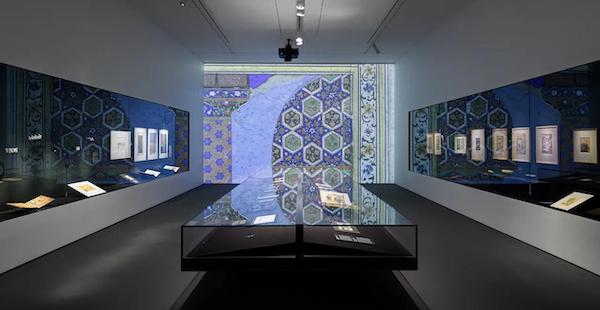
View of the special exhibition "Cartier and Islamic Art: The Search for Modernity", photo: Dallas Museum of Art
In the same year, the Dallas Museum of Art in the United States launched the special exhibition "Cartier and Islamic Art: Searching for Modernity", which affirmed the artistic contribution of South Asia's oriental art to high-end custom jewelry.

Special Exhibition "Cartier, Islamic Inspiration and Modern Design" Photo: Louvre Abu Dhabi
At the end of this year, the Louvre Abu Dhabi in the United Arab Emirates launched a special exhibition "Cartier, Islamic Inspiration and Modern Design" to present the intersection of Eastern and Western civilizations in jewelry, leading jewelry lovers to cross the cold winter and welcome the spring of 2024. The exhibition will last until March 24, 2024.
